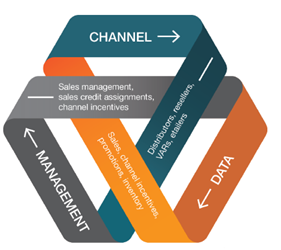Manufacturers Look Deeper Into Their Sales Channels To Improve Quality And Market Responsiveness

By Bernard Leikind, PhD
During the latter half of the twentieth century, the ideas of W. Edwards Deming and other engineers and statisticians transformed manufacturing – first in Japan and then worldwide. Deming and his followers advocated the reform of management through the rapid flow of information along production lines to managers and upstream to suppliers. This flow of information, by physical tickets such as Kanban in pre-computer days, is not enough, however. Deming urged the use of innovative statistical methods to discover sources of product variation.
Deming envisioned enlisting workers at all levels of an organization into a team with unified goals, providing them with the information and power to continually improve production quantity and quality. By documenting workers’ efforts, executives can distribute rewards to align everyone’s interests. This also creates long-term ties between manufacturers and suppliers as the manufacturers influence suppliers to adopt the same techniques. Just-in-time manufacturing, for example, requires that suppliers be prepared to respond rapidly to changing manufacturing demands, while maintaining essential qualities, such as low variance.
Newer methods today involve computers, networks, and the Internet to create immediate, worldwide connections and responses to reduce excess inventories and tie manufacturers more closely to their suppliers and channels. Although these ideas involve collecting data along the entire production system from raw materials to finished products, the essential idea is not so much to catch errors, but to gain control of variances in materials, methods, and workers to produce quality by design.
Manufacturers are spreading these methods downstream along sales channels. Their goals are for market intelligence to flow upstream from end user customers through intermediaries such as distributors, dealers, and online resellers back to the manufacturers. In this way, manufacturers can respond more quickly to changing market conditions while reducing unnecessary and wasteful downstream inventory. Specialized channel applications and the cloud are also contributing new resources to knit the various firms, workers, processes, and customers into tighter nets.
The latest evidence shows that these new tools and modernized processes are paying off.
Consider, as an example, the complexity of current sales systems that involve staff from several organizations along the channel from the manufacturer to the customer. To ensure that each worker at each level focuses his or her attention on the interests of the manufacturer in a collaborative manner, it is necessary to track and assign sales credit appropriately. Information about customer wants and needs should also be returned upstream to inform marketing, production, and product management to aid in manufacturing and product planning.
Modern global distribution systems require flexibility, speed, and low inventories to ensure the greatest efficiencies and optimized profits. In sluggish distribution systems that require substantial inventory in the channels, distributors may be caught with unsellable products when demand changes or manufacturers introduce upgraded models or entirely new products. Distributors then have to liquidate outdated inventory at a steep discount, or return it to the manufacturer, who then absorbs the loss.
Newer rules from the U.S. Securities and Exchange Commission and similar agencies in Asia and Europe are designed to prevent “channel stuffing” and the reporting of revenue by manufacturers from products shipped to distributors and held in inventory with no prospect of a final sale. They also require firms to accurately track and monitor products from shipping docks all the way to the final consumer. Some organizations are still challenged in complying with these mandates.
Forrester Research, Inc. reports that manufacturers are increasingly turning to commercially available channel data management systems to help them optimize incentives, inventory, revenue recognition, and compliance management. These include, for example, Dell, Logitech, Motorola, Phillips, Plantronics, SanDisk, Sharp, Symantec, and Xerox, among many others, which use a powerful channel data management platform produced by Zyme Solutions, a California software vendor.
Zyme’s founder and CEO, Chandran Sankaran, says that his firm’s cloud-based solutions are enabling producers to make “transformational shifts in how they sell, how they market, and how they manage their inventories.”
Other channel data specialty firms that Forrester cites include Channelinsight, Computer Market Research, and Entomo. According to Forrester, Zyme is the leader among these firms as it “maintains a global directory of 600,000 reporting channel partners, collects data feeds originating from 180 countries, and amasses 15,000 data feeds per week.”
Mathew Feetterer, Senior Manager for North America Channel Sales Operations at Motorola, says that channel data reporting at his company “starts at the account manager level, and aggregates up to the territory and regional levels, across product lines, vertical markets, and end customer accounts. The insights gained from this data allow us to alter course as needed and take corrective actions to drive more sales and position ourselves for future business in a changing marketplace.”
The Deming movement tied manufacturers to their suppliers to produce tighter integration, more rapid response, continually improving quality, and higher profits. These desired results are now arising from an acceleration of data flows and analyses within the sales and marketing channels of some of the world’s most agile data-enabled companies.
Bernard Leikind, PhD, is a physicist, thinker, and student of history and economics.
